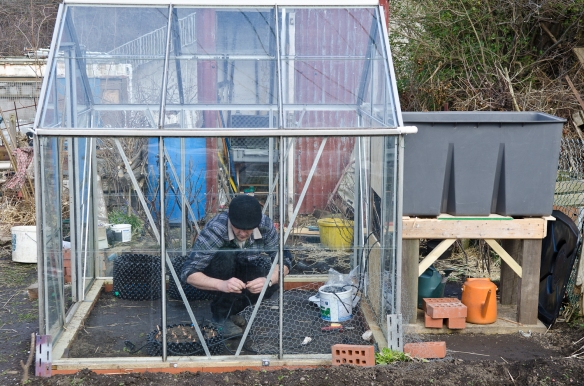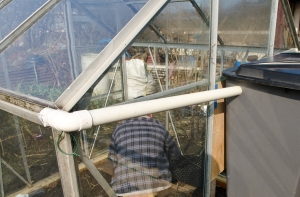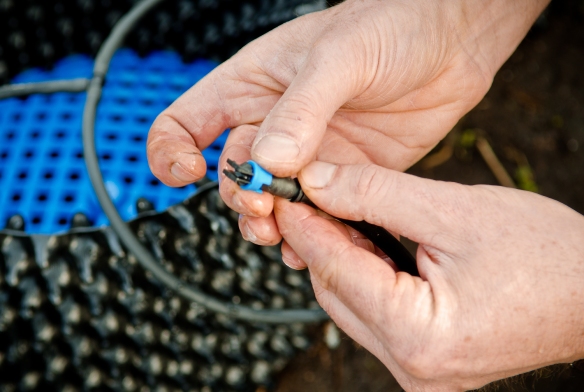The new greenhouse has been built at the allotment & the plan is to have it full of chillies, peppers, tomatoes, aubergines, cucumber & maybe a melon by the summer. Everything will be grown in Air-Pot containers to maximise yield from what is a very small greenhouse 6′ x 6′ (1.8 x 1.8m). The root system which develops in an Air-Pot is very dense so it is crucial to keep the pots well watered. A big vine tomato on a hot day really needs to be watered twice if relying on a watering can. I cannot manage twice daily visits to the plot so have set up a drip irrigation system.
 This should mean the greenhouse will be self watering for at least a few days. I have set up a water tank next to the greenhouse connected to the gutters, so it will fill with rainwater, with the fall back of using a hose if there is a prolonged dry spell. The tank I used is a salvaged cold water storage tank, the type that used to be in every loft but often goes in the skip when new systems are installed. It holds 50 gallons, sits on a platform and creates a head of pressure to feed the water lines to the plants.
This should mean the greenhouse will be self watering for at least a few days. I have set up a water tank next to the greenhouse connected to the gutters, so it will fill with rainwater, with the fall back of using a hose if there is a prolonged dry spell. The tank I used is a salvaged cold water storage tank, the type that used to be in every loft but often goes in the skip when new systems are installed. It holds 50 gallons, sits on a platform and creates a head of pressure to feed the water lines to the plants.
I bought a 30 plant kit from www.tankfedirrigation.com, which is one of the few gravity fed systems. It seems to be pretty high quality & should last 10 years, about the same as an Air-Pot. A good feature is the adjustable water emitters which can be easily unblocked if required. The kit came with good instructions, the initial set up was straightforward & everything worked with no leaks, which is unusual for any plumbing job in my experience.
I expect to have around 15 pots in this greenhouse, each with 2 water emitters. I am sure there will be a fair amount of fine tuning to get the right amount of water where it is needed. It would be nice to know that if I am away for 3 or 4 days in the summer my plants will not go thirsty, & during longer absences if a kindly neighbour is prepared to water at least they will only need to top up the tank occasionally.




I’d be interested to know how you got on with the Tank fed irrigation system . I tried It several years ago but found it almost impossible to accurately control the drip valves, also I had severe problems with the tubing becoming blocked with a sticky sludge which was akin to a glue. I never did find out what caused It and despite my washing and scrubbing everything out ( each season) using washing up liquid and rinsing with running water it still came back .
By the way I love the blog.
LikeLike
Hi Andrew
Sorry to hear of your difficulties with the Tank Fed Irrigation system, I agree controlling the flow rate can be “approximate” but I always visually check all the drippers before leaving unattended to see if any are drastically under or over dripping. Occasionally when the filter inside the tank has been disturbed i have had particles clogging the in-line filter of the timer, it helps keeping the tank well covered and dark, my open rain butt was colonised this year by the most horrific looking creatures, rat-tailed maggots which looked like they would eat your arm off so I am sure would clog an irrigation system. Ideally the outlet from the tank should be slightly above the sludgy base of the tank, I guess an additional layer of gauze or netting around the tank outlet filter might be worth trying, I found if an emitter / dripper was clogged the squeezy construction made it easy to dislodge particles, your sticky gunk sounds stubborn though, I did find ants had laid eggs inside the tubes once after the system had been unused early in the season. Also I did find the system performs poorly as the water pressure drops when the tank is nearly empty, so I try to top up before it is less than about 1/4 full, raising the height of the reservoir would also increase pressure. I only water using the drip system and feed separately from a watering can, I know some growers add feed to the irrigation water but this seems an unnecessary clog hazard. Another tip which eases assembly and dismantling is to use the merest smear of silicon lubricant on fittings, this avoids needing to pull hard on rubber tubing when disassembling, silicon lubricant is used by plumbers on push-fit drainage pipe…or you could use a little washing-up liquid.
LikeLike